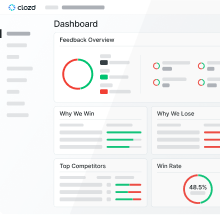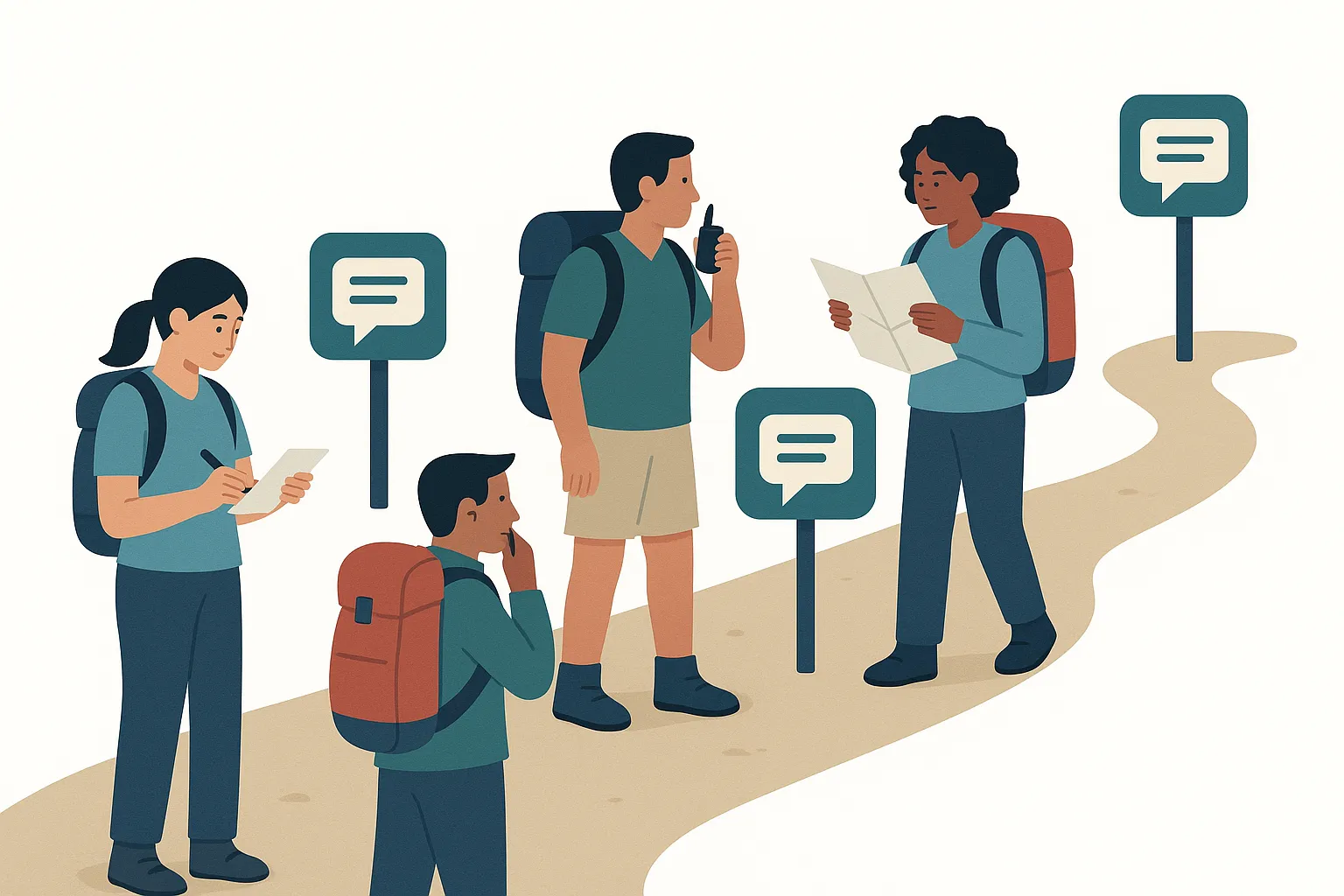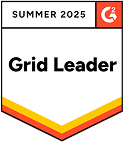TL;DR
- Win-loss and churn analysis programs help you understand different types of sales opportunities (new vs. existing business).
- It's critical to create internal buy-in from your leadership, sales, and sales ops teams.
- Determine who to collect feedback from based on specific segments.
- Tips on how to create an interview guide, schedule interviews, and analyze feedback.
- Present findings to stakeholders—and consider working with a professional third party (like Clozd) to optimize and scale your program.
Introduction
Many organizations want to understand why they’re winning and losing sales opportunities—but they don’t have a systemic approach to do so. If that’s the case for your organization, you’re ready to start a win-loss or churn analysis program.
In this blog post, we’ll focus on how to collect feedback from new business (win/loss) opportunities and existing business (churn/stay) opportunities. The process of running a win-loss program versus a churn program are similar, with some nuance. By the end of this post, you’ll have a comprehensive understanding of how to run your win-loss program—and a far better idea of how much work typically goes into setting up and running the program.
Gain internal buy-in
An important beginning step with any win-loss program is gaining internal buy-in from the appropriate teams and stakeholders. We’ve worked with thousands of companies, and we’ve seen that it’s most important to get buy-in from the leadership team, sales organization, and sales/revenue operations team. The most reliable way to do this is to demonstrate the value of win-loss analysis through …
- Conducting 1–2 interviews
- Showing the key stakeholders the insights that were collected in the interviews
- Building a business case that shows clear ROI from running a win-loss/churn program
Leadership
While it may seem obvious that you need to get buy-in from the leadership team, many orgs don’t do this well (or at all). Boards and executive teams with access to accurate, real-time win-loss data make more informed decisions—and they make them quicker (with less debate) and act on them with more confidence.
Because of this, win-loss programs that are sponsored by the C-suite are more likely to receive the funding they need, drive change across multiple departments, and achieve a meaningful ROI for the business. If it’s not possible to get buy-in from each member of the leadership team, prioritize getting buy-in from specific leaders—in product, sales, and marketing—as well as your CEO.
Sales
Getting buy-in from your sales team can typically make or break your program.
The sales team maintains buyer relationships and may have veto power over which opportunities you can and can’t reach out to. We strongly recommend securing support from your sales leadership team AND as many individual sales reps as possible.
- Try to get sales leadership involved early on. Make them feel like it’s their program just as much as it’s your program.
- Allow them to help build the question set and have a say in the program’s outcomes.
- Find a sales rep that’s respected throughout the organization and—to get them excited about the feedback that’s collected—ask them if you can interview a few of their recent opportunities.
Sales Ops
Lastly, we recommend getting buy-in from your sales/revenue operations team. They’re often the gatekeeper for buyer contacts, and being able to access and reach out to those contacts is critical to getting enough feedback to run a successful program. You’ll also need access to your CRM in order to create a consistent (and automated) cadence to reach out and schedule interviews.
Determine who to collect feedback from
The most important outcome from your win-loss analysis program is understanding where you’re losing—so you can improve your win rate within specific segments. To do this, you’ll need to determine who you need to interview.
If you have a high churn rate and you’re not sure why, you might want to focus on existing business instead of new business. If your churn rate is doing well but your win rate on new business is suffering, then you could focus on other segments, such as pipeline bands, competitors, regions, and more. Let’s say, for example, that you have a high win rate on enterprise deals but your mid-market win rate is low. In this case, it’s probably best to focus your interviews on mid-market opportunities to gain a better understanding of why you win and lose those deals.
Create an interview guide
While you’re in the process of choosing which contacts to invite to an interview, you’ll need to create your interview guide—a set of questions that you can ask during an interview. The specific questions you will ask typically vary depending on who you're interviewing (e.g., new business vs. existing business may need two separate interview guides). We recommend thinking of your interview guide not as a strict set of questions that you have to ask in every single interview, but rather a set of questions that could be asked during an interview. Your guide should be extensive and exhaustive, but it’s important to realize that not every question will be asked during each interview. It’s simply meant to guide the conversation.
The topics within your interview guide may also vary, but some common topics include “overview and origination,” “sales process experience,” “product offering,” and more.
Schedule your win-loss interviews
If not done correctly, this part of the process can be frustrating and discouraging. While buyers are typically more likely to agree to participate in an interview over something like a survey, participation rates can become a key part in your program seeing success or falling by the wayside. Here are some helpful tips:
Offer incentives
Offering an incentive—usually in the form of a gift card—is a simple way to show appreciation that your buyers are taking time out of their day to participate in an interview. While this isn’t critical to achieving a high participation rate, it does boost participation rates enough to make it worthwhile.
Use an email service
Whether you’re integrating with your CRM or reaching out to a list that was pulled from your CRM, consider using an email service rather than sending emails one-by-one.
Use a scheduling service
Try to make it as easy as possible for your buyers to participate in an interview. Instead of emailing back and forth to find a time that works for both parties, consider manually adding a calendar invite with call-in information added. Scheduling services like Calendly, Zoom Scheduler, or HubSpot can help with this.
Be persistent—while maintaining professionalism
The natural instinct is to send only one or two emails, so you don’t annoy your buyers. The best advice here is to demonstrate professional persistence. There’s no perfect answer as to how many email reminders you should send, but we typically recommend 1–5 reminders.
Send an introduction email
Since it’s unlikely (and not recommended) for the people directly involved in selling the deal to run the win-loss program, we still recommend that you have someone your buyer knows—ideally the sales rep they’re working with or a senior leader within your organization—send an introductory email. This will help you achieve a higher participation rate, because it helps alleviate any concerns about legitimacy. The key elements to highlight in the email are: that your organization is running a win-loss analysis program, how they’ll use the insights, and who will be reaching out to schedule the interview (which is usually someone from a different team or from an external third-party vendor).
Track participant history
Another important element is to track participant history. Track moments such as: who has agreed to an interview, who has opted out of emails, who has bounced, who has been interviewed previously, and more. This ensures that you’re not reaching out to buyers who should be off-limits. Utilizing an email service will likely be able to help with this. Otherwise, defer to a spreadsheet.
Conduct your win-loss interviews
Now that you’ve created your interview guide and your buyers have scheduled interviews, it’s time to conduct your interviews. There’s debate on the correct methodology when conducting interviews. Should you:
- Ask every single question in each interview and essentially use the interview guide as a script?
- Conduct a dynamic and adaptive interview based on the feedback that the buyer is providing and use the interview guide simply as a guide?
The answer comes down to what you’re trying to accomplish. At Clozd, we prefer to conduct dynamic and adaptive interviews, because our goal is to find out why a deal was one or lost. We believe we’re more likely to uncover those insights with flexibility rather than rigidity.
Record, transcribe, and clean/edit the interview
While it may seem natural to take meticulous notes while conducting the interview, we strongly recommend against this. Yes, take basic notes. But instead of only relying on your notes, it’s best practice to record and then transcribe the interview. Our advice is to do everything you can to focus on the interview and ask the best questions (and follow-up questions) that you can. If you’re so focused on taking notes that you’re not actually listening to what the buyer is saying, you won’t be able to formulate the most appropriate follow-up questions.
There are several options available for transcribing your recorded interviews:
- Do it yourself. High-quality transcriptions, but this demands a lot of time.
- Hire a human transcription company. High-quality transcriptions with quick turnaround times (~5 hours), but can be expensive (~$1.50 per minute of recording time).
- Use an automated transcription service. Low-quality (but getting better), inexpensive (typically free), and instant. It’s also critical to use a service that will protect your company’s privacy and confidentiality.
Summarize the interview
Once you’ve conducted the interview, it’s important to highlight key takeaways from the interview. You can do this by writing a high-level but thorough summary that focuses on why the buyer made the decision that they did, including strengths and weaknesses. It’s also a good idea to concisely tag themes that came up during the interview (e.g., sales process, product offering, etc.). You can also tag common words that may not have been the primary drivers of the decision but are still important to track and understand—like how frequently a competitor name, product name, or sales rep name came up during the interview.
Analyze the feedback
Now that you’ve successfully conducted, transcribed, and tagged several win-loss interviews, you can begin analyzing the feedback. There are two key ways to begin analyzing the feedback:
- Analyze the individual interview.
- Analyze feedback across all the interviews that have been conducted.
Each interview contains a wealth of information—but don’t jump to conclusions based on only one or two data points. Make sure you’ve collected enough data to see trends emerge before making significant changes. This is why it’s important to tag themes in each interview, so you can aggregate them across all the data points and begin to see a clear picture of your strengths and weaknesses. We recommend conducting at least 20 interviews within a particular segment (e.g., deal size over $50,000, in North America, against Competitor X, about a specific product line, etc.) and then see what themes continually come to the top. Then, once you’ve learned why you’re winning and losing within one segment, move on to the next.
If you’re not using some type of software to aggregate your win-loss interviews, it becomes more difficult to analyze and keep track of your findings. Something like Google Drive or Dropbox would likely be the best place to store all of your interviews.
Present your findings
Once you’ve collected enough data and analyzed it to uncover your key strengths and weaknesses, it’s time to present your findings to the appropriate stakeholders. Back at the beginning of this post, we identified the people who must play an important role in your company’s win-loss analysis program—your leadership team, sales, and sales ops, among others. Review your findings together and determine which changes will have the most impact on your win rate. You should be able to determine clear action items as an outcome of this meeting.
Working with Clozd simplifies this process
Now, this may feel like a large undertaking—but we believe in you! The good news is that we can actually take the majority of this work off your plate. We’ll run your win-loss program for you, enabling you to spend less time on win-loss logistics and more time on enacting change.
Here’s a breakdown of what Clozd can help with and what you’ll still need to do yourself if you engaged with us …
You
- Gaining internal buy-in will mostly be done by you and your team—but with our help and expertise. Additionally, we’ve created a business case template and ROI calculator to help you engage and educate key stakeholders.
- It’s still your responsibility to work with the appropriate stakeholder(s) to deliver a list of buyer contacts for us to interview for you, but we make the CRM integration completely seamless and easy.
- While we have a template for your interview guide, you’ll still need to shape that guide based on the specific questions you’d like to ask.
- While we will build the reports—and even present them to anyone at your organization, including your leadership team—it’s your responsibility to take those win-loss insights and use them to create strategy and enact change. But again, we’ll help.
Us
We’ll do literally everything else …
- We’ll schedule all the interviews, because the entire scheduling process is built into the Clozd Platform.
- We’ll conduct every interview and summarize the findings from each interview.
- We’ll run the incentive process for each buyer that participates in an interview.
- We’ll deploy additional tactics to ensure a higher participation rate.
- We’ll utilize different feedback channels depending on the segment that you’re looking to get insight on (e.g., Flex Interviews for small SMB deals vs. premium live interviews for larger enterprise deals).
- We’ll transcribe the interviews and allow you to easily listen to each interview, right within our platform.
- We’ll aggregate the findings across all the interviews we conduct, including from other win-loss channels such as surveys or Flex Interviews.
- We’ll create reports that make it really easy to understand your strengths and weaknesses—and we’ll present these findings to any team at your org.
- We’ll help you win more.











.svg)




.png)






.svg)

.svg)




